Sleep apnea is no joke. It robs you of good sleep and can negatively affect your health in a number of ways. I personally deal with sleep apnea, and I’m glad that I sought treatment.
I’m also glad that I invested in a pillow for my sleep apnea. The right pillow can keep you comfortable and possibly decrease your symptoms. I’ve put together my list of the best pillows for sleep apnea. If you struggle with sleep apnea, read on to find the right pillow for you!
Our Verdict: What’s the Best Pillow for Sleep Apnea?
I named the Helix Wedge pillow as one of the best pillows to help alleviate sleep apnea symptoms. This is because the design of this pillow allows you to elevate your torso, which puts you in a more upright position. This position will help keep your airways from collapsing from obstructive sleep apnea (OSA), which will help you get a better night of sleep.
The 7 Best Pillows for Sleep Apnea
- Helix Wedge Pillow – Best Wedge Pillow for Sleep Apnea
- Saatva Memory Foam Pillow – Best Pillow for Snoring and Sleep Apnea
- LUXOME LAYR – Best Adjustable Pillow for Sleep Apnea
- Layla Kapok – Best Pillow for Side Sleepers with Sleep Apnea
- TEMPUR-Neck Pillow – Best Pillow for Sleep Apnea and Neck Pain
- Lundberg CPAP Pillow – Best Pillow for Obstructive Sleep Apnea
- Sutera – Best Cervical Pillow for Sleep Apnea
How We Chose The Top Pillows for Sleep Apnea
The Mattress Clarity team has tested hundreds of pillows and mattresses. For this roundup, we focused on pillows that will accommodate Continuous Positive Airway Pressure (CPAP) machines and promote side sleeping, the best position for those with sleep apnea.
The following list is based on my own experiences with sleep apnea and the recommendations of sleep doctors and sleep specialists.
Helix Wedge Pillow – Best Wedge Pillow for Sleep Apnea
Helix Wedge Pillow
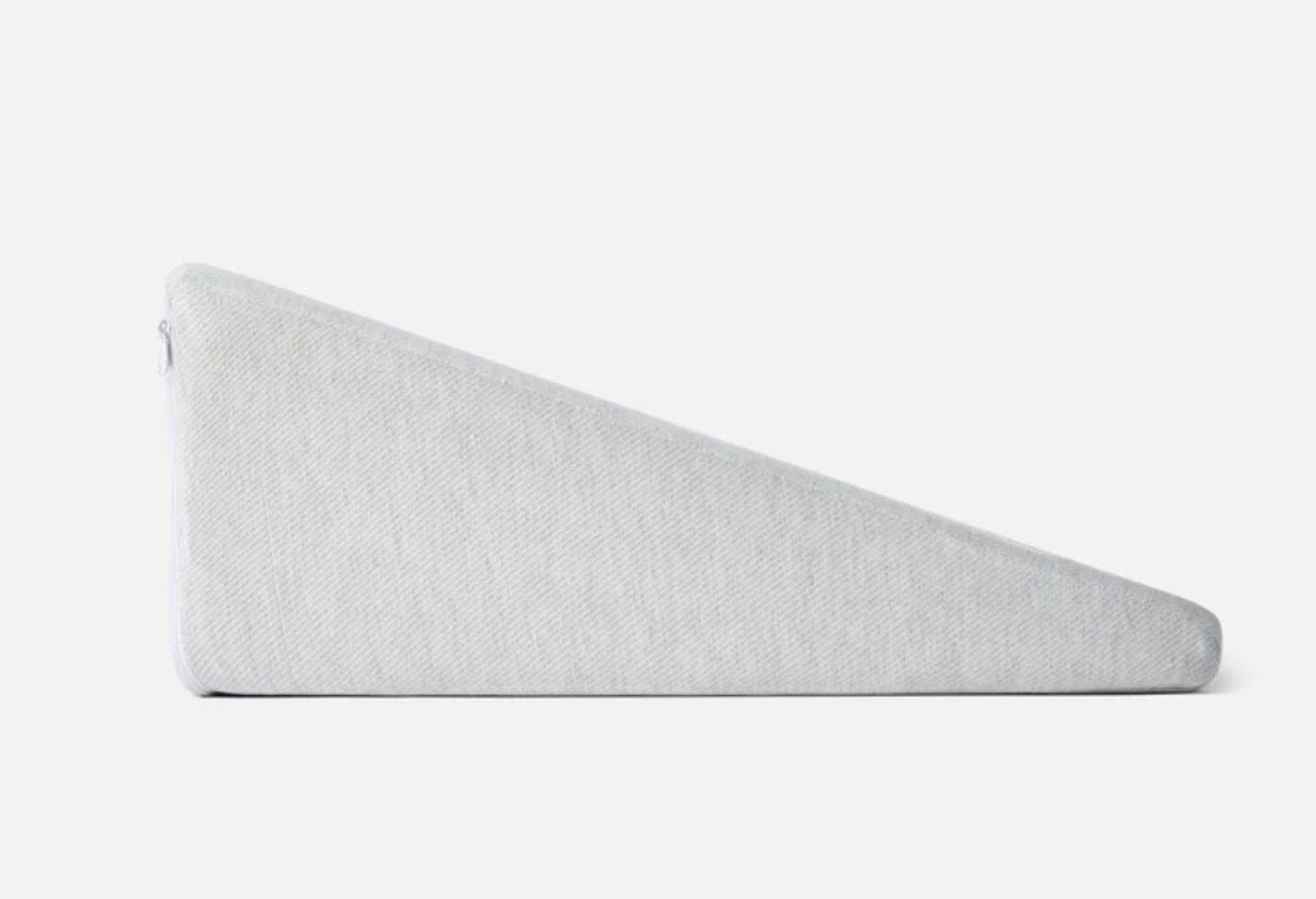
The Helix Wedge is a pillow effectively combat snoring and acid reflux.
Mattress Clarity Score
4.30 / 5
Our Expert’s Take
Side sleeping is the ideal position for sleep apnea, but if you need to sleep on your back, a wedge pillow is the way to go. The Helix Wedge pillow is one of my personal favorites and will keep your head elevated while you sleep. Studies show that this can prevent your throat from collapsing while you sleep and decrease apnea incidents. Combined with treatment, the Helix Wedge could be an effective pillow for sleep apnea.
In addition, if acid reflux is an issue for you, the Helix Wedge pillow can help! Elevating your head can prevent acid from traveling up your esophagus, causing reflux.
What We Love About the Helix Wedge Pillow
- The top edge of this wedge pillow features CertiPUR-US gel-infused memory foam. This foam disperses body heat and will prevent sleepers from overheating.
- The Helix Wedge pillow can also be used to prop your torso up to watch TV in bed or under your calves to take pressure off your lower back.
- In addition to managing sleep apnea symptoms, sleeping elevated on a wedge pillow can help reduce symptoms related to GERD (Gastroesophageal reflux disease).
What to Keep to in Mind About the Helix Wedge Pillow
- As a support pillow, the Helix Wedge pillow is very firm, especially on its taller end. It won’t provide much pressure relief compared to a traditional memory foam pillow.
- The Helix Wedge pillow at its tallest is 10”. Some back and side sleepers may prefer a shorter wedge pillow so they are not as elevated.
Read our full Helix Wedge pillow review.
Saatva Memory Foam Pillow – Best Pillow for Snoring and Sleep Apnea
Saatva Memory Foam Pillow
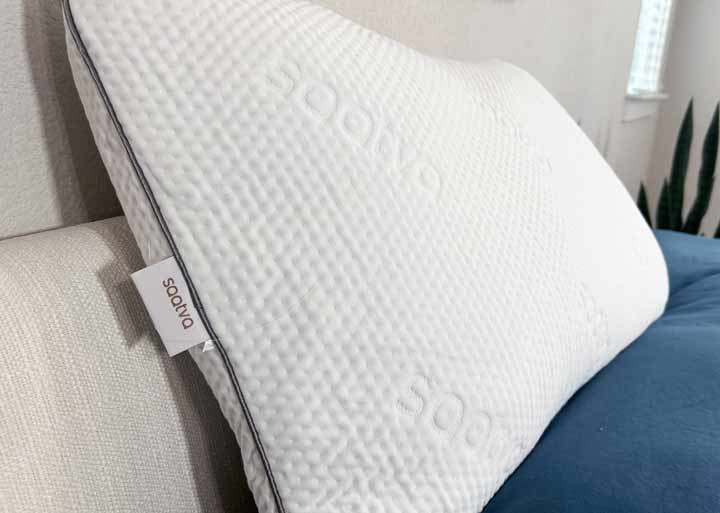
If you love high-quality memory foam that is soft but supportive, check out the Saatva memory foam pillow.
Our Expert’s Take
One of the main symptoms of sleep apnea is snoring. But, whether you have sleep apnea or not, side sleeping is the best position to curb snoring. That’s why I’m such a fan of the Saatva Memory Foam pillow. It boasts thick, comfortable memory foam that offers the proper amount of support for side sleeping.
And, the Saatva Memory Pillow has that slow-moving feel you expect from memory foam. Lying down, you’ll feel the foam slowly take the shape of your head. You’ll get the support you need for side sleeping while still feeling very comfortable.
What We Love About the Saatva Memory Foam Pillow
- Between the Saatva pillow’s cover and its shredded memory foam core is a layer of graphite-infused foam to pull heat away from your body. This is a great pillow for hot sleepers that also want to minimize their snoring.
- Its shredded memory foam core can be removed if you want to sleep on a shorter pillow for back or stomach sleeping.
- The Saatva Memory Foam pillow has a slow-moving feel that gently cradles your neck and head, but you shouldn’t feel “stuck inside” the pillow.
What to Keep to in Mind About the Saatva Memory Foam Pillow
- If you have broad shoulders, this pillow may not be tall enough for side sleeping. At its tallest, its loft, or height, is 5”.
- Whenever you first open the pillow’s packaging, you may notice a slight chemical smell. This is called off-gassing, and it should dissipate after 24 hours.
Read our full Saatva Memory Foam pillow review
LUXOME LAYR – Best Adjustable Pillow for Sleep Apnea
Luxome LAYR Pillow
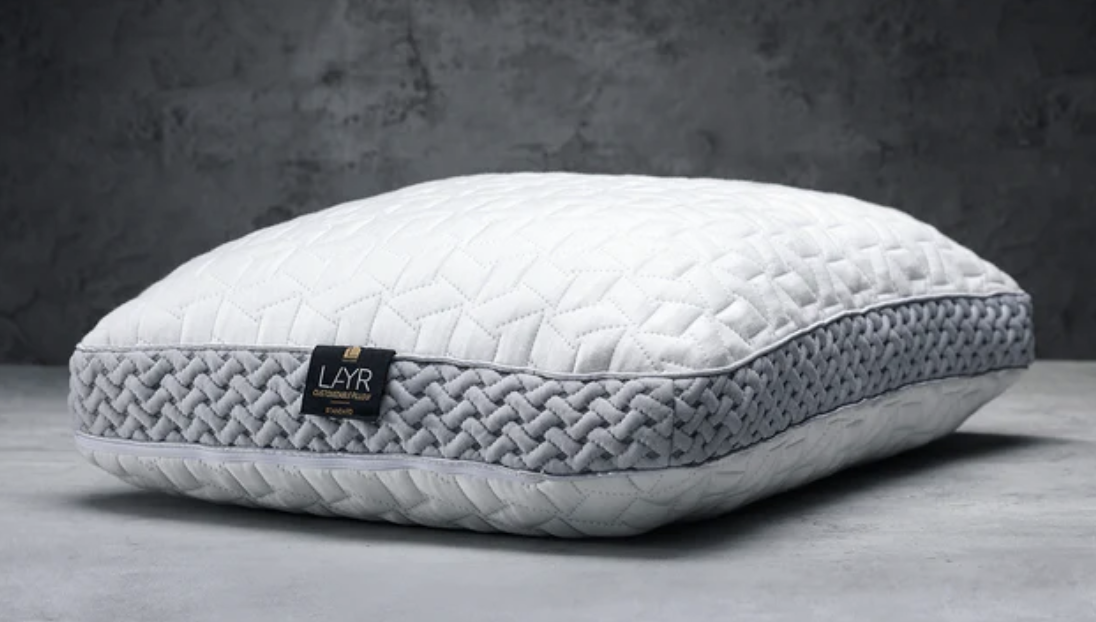
The LUXOME LAYR Pillow is a high-quality adjustable option that allows you to create your own comfort.
Our Expert’s Take
Here at Mattress Clarity, we’ve reviewed a number of adjustable pillows. But a lot of them involve taking out or adding in memory foam. This process can take a while to find that “Goldilocks” feeling. But with the LUXOME LAYR pillow, you have three different fills, each with their own firmness, to help make the adjusting process easier.
The LAYR comes with three fill layers: soft, medium, and firm. The soft is full of down alternative, the medium features shredded foam, and the firm is a single slab of memory foam. Because this pillow is easy to adjust, it’s earned our best adjustable title. If you prefer to sleep on your side, combining the medium and firm layers can help make the pillow tall and firm enough to support your head while you sleep.
What We Love About the LUXOME LAYR Pillow
- The memory foam has a gel infusion and the inserts go inside a bamboo outer cover. Gel infusions are designed to pull body heat away from you, and the bamboo is moisture-wicking and breathable. With this combination in mind, you shouldn’t overheat while using this pillow.
- The three inserts with different firmnesses make it easier than other adjustable pillows to find that sweet spot. If you’re trying to train yourself to sleep on your side to help with sleep apnea, you can use the medium and firm inserts to make the pillow tall and supportive for side sleeping.
What to Keep In Mind About the LUXOME LAYR Pillow
- At full price, the LAYR is about $120, without a seasonal discount. For some, this pillow’s price could be out of budget.
- While it may be possible to stick all three pieces in the outer cover to maximize height and firmness, this isn’t recommended. The outer cover can only handle two inserts inside the pillow at a time. All three might put strain on the outer cover, causing it to stretch and potentially rip.
Read our full LUXOME LAYR pillow review.
Layla Kapok – Best Pillow for Side Sleepers with Sleep Apnea
Layla Kapok Pillow
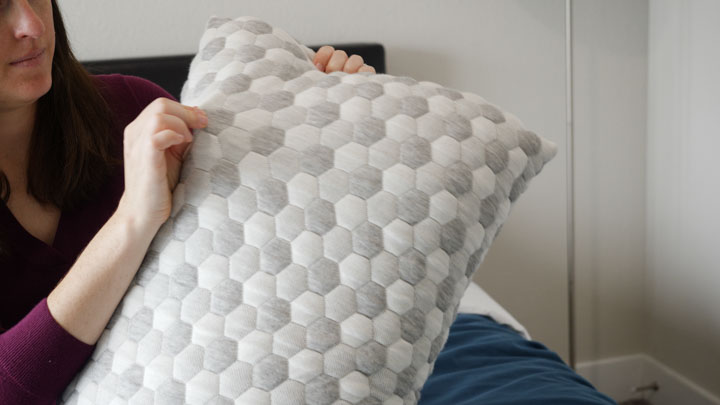
The Layla Kapok pillow combines shredded foam and natural kapok tree fibers to give you a great balance of comfort and support. You can also take out some of this fill to adjust the height of the pillow to make it work for you.
Mattress Clarity Score
4.50 / 5
Read Full ReviewOur Expert’s Take
Side sleeping is the best position for sleep apnea as it helps keep your airway open. Out of the many pillows I have tried, the Layla Kapok is one of the most comfortable. It features a blend of shredded memory foam and Kapok fibers, which are natural and breathable. Both materials help create a comfy pillow that is also supportive for side sleeping. Lying on your side, the Layla will keep your head elevated, promoting neutral spinal alignment.
Memory foam is known for sleeping hot, but this shouldn’t be an issue with the Layla Kapok pillow. The cover is breathable and the Kapok fibers keep the air flowing through the pillow. You’ll be side sleeping in cool comfort on the Layla Kapok.
What We Love About the Layla Kapok
- The Kapok pillow has an adjustable loft, but is tall enough to keep side sleeper’s neck and head in neutral spinal alignment.
- Its breathable polyester and rayon cover has copper fibers sewn inside to regulate body temperature. This pillow is a great choice for hot sleepers.
- The Kapok’s pillow’s foam filling is CertiPur-US Certified, which means it’s made with harmful chemicals and materials.
What to Keep to in Mind About the Layla Kapok
- You may notice a slight chemical smell when you first unbox the Layla Kapok. This off-gassing is normal and should disappear after 48 hours when placed in a well-ventilated room.
- The Kapok’s cover can be removed and is machine-washable, but the entire pillow cannot be placed in a washing machine or dryer.
Read our full Layla Kapok pillow review
TEMPUR-Neck Pillow – Best Pillow for Sleep Apnea and Neck Pain
TEMPUR-Neck Pillow
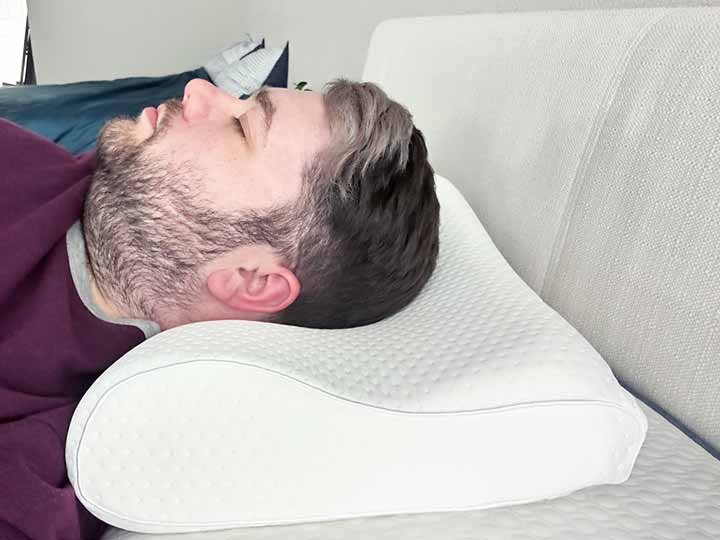
The ergonomic shape to the TEMPUR-Neck pillow makes it an ideal pillow for anyone dealing with neck pain. This solid slab of memory foam will contour to your head and neck, giving you good support and will alleviate neck pain.
Mattress Clarity Score
3.90 / 5
Read Full ReviewOur Expert’s Take
If you struggle with neck pain in addition to your sleep apnea, you want a pillow that will ease and prevent this pain. That’s why I like the TEMPUR-Neck pillow. It features an ergonomic design that will soothe your neck pain while you are side sleeping. You’ll be able to lie in the right position for sleep apnea without being in pain.
It is also made of high-density TEMPUR material that is comfortable but also supportive enough for both back and side sleepers.
What We Love About the TEMPUR-Neck Pillow
- The TEMPUR-Neck comes in three different sizes and lofts, allowing you to find the perfect fit for you.
- Its exterior cover is hypoallergenic and machine-washable. TEMPUR-Pedic recommends washing the removable cover on a cold wash setting and letting it air-dry.
- This pillow is sold with a five year warranty which covers defects from manufacturing.
What to Keep to in Mind About the TEMPUR-Neck Pillow
- Pillows made from one piece of memory foam tend to trap body heat, and unfortunately, the TEMPUR-Neck pillow does not come with any cooling features. However, TEMPUR-Pedic does sell a cooling version of the TEMPUR-Neck pillow.
- Because TEMPUR-Pedic considers pillows to be a personal item, returns are not allowed.
Read our full TEMPUR-Neck pillow review
Lundberg CPAP Pillow – Best Pillow for Obstructive Sleep Apnea
Lundberg CPAP Pillow
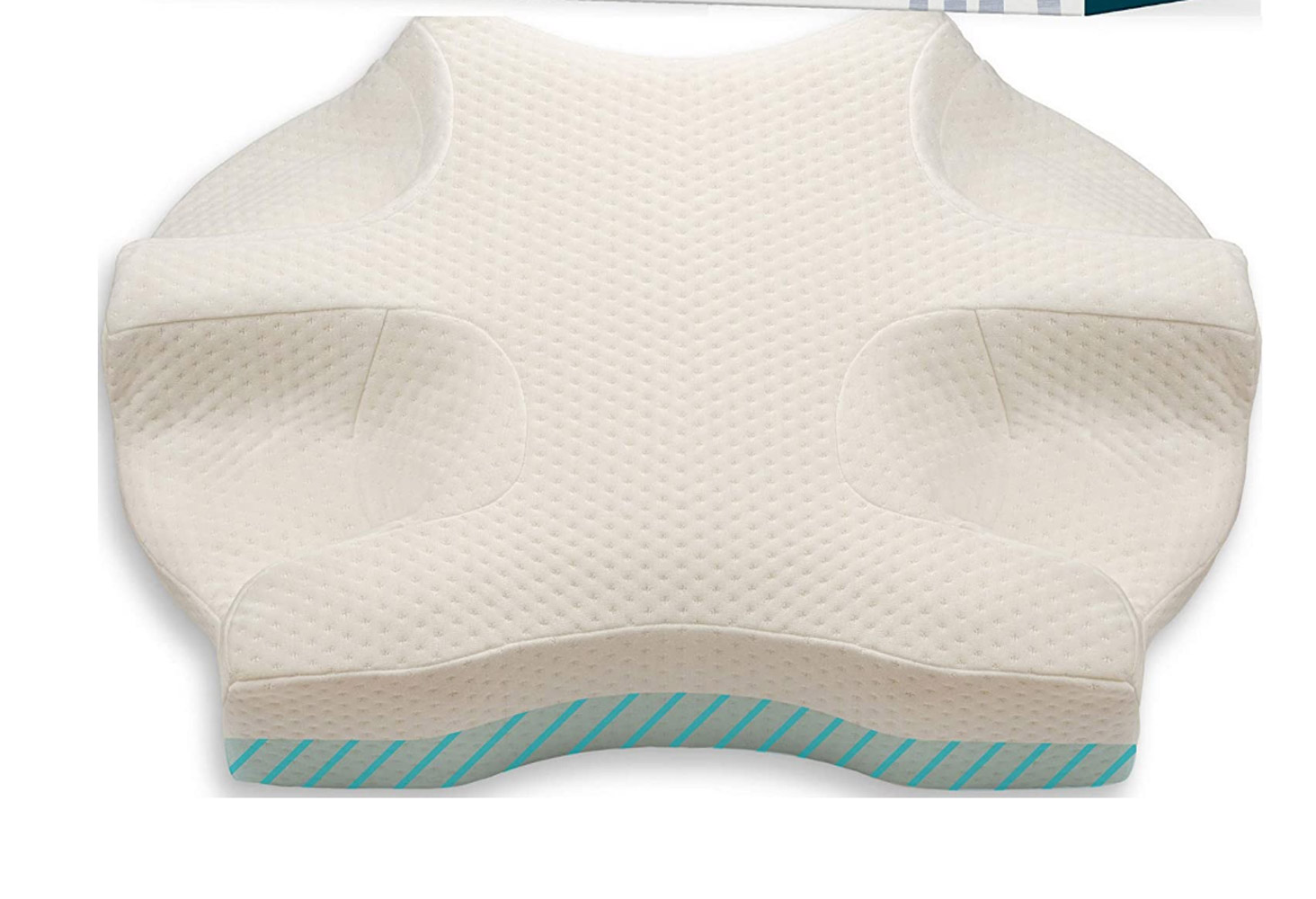
The Lundberg CPAP pillow makes side sleeping with your CPAP machine comfortable.
Our Expert’s Take
If you are diagnosed with sleep apnea, your doctor may prescribe a CPAP machine. You will wear a CPAP mask on your face, and this can make sleeping difficult, especially when you are on your side.
This is what the Lundberg CPAP pillow is all about. It is designed with special grooves that leave room for your CPAP mask and hose. As a side sleeper with a CPAP, I can tell you how helpful this is. My CPAP mask and hose get bunched up on normal pillows, but this isn’t an issue with the Lundberg.
What We Love About the Lundberg CPAP Pillow
- What makes this sleep apnea pillow unique is that it accommodates back, side, and stomach sleeping while you are wearing a CPAP mask.
- It is sold with two pillowcases: one for standard use and one with cooling features for hot sleepers or to use during the warmer months.
- There is a bottom layer of 1.5” thick memory foam that can be removed to fit sleepers with different body types.
What to Keep to in Mind About the Lundberg CPAP Pillow
- Some negative reviews mention that the pillow was too firm for their liking. This pillow doesn’t offer much pressure relief because it is a solid piece of foam.
- You may notice a slight chemical smell from this pillow right out of the box, but it should disappear after 48 hours.
Full review coming soon.
Sutera – Best Cervical Pillow for Sleep Apnea
Sutera Dream Deep Pillow
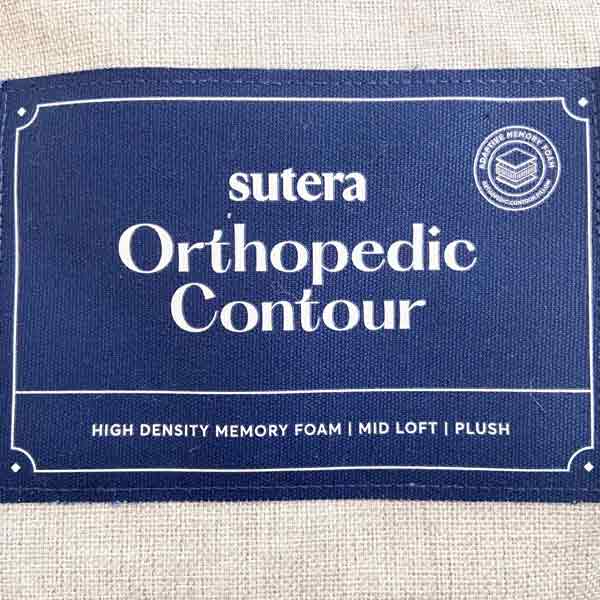
The Sutera pillow has a unique contoured shape that will keep your spine in its natural, curved state. All three sleeping positions will enjoy this pillow due to its soft foam feel and unique contoured shape.
Mattress Clarity Score
3.90 / 5
Our Expert’s Take
No matter what position you sleep in, spine alignment is so important. You want a pillow that will keep your head aligned with the rest of your body. This is where a cervical pillow like the Sutera can come in handy. With an ergonomic design, the Sutera will keep your head perfectly supported whether you sleep on your back, side, or stomach.
The Sutera is also a great value pick. If you struggle with sleep apnea, you won’t have to break the bank to get the comfort and support you need.
What We Love About the Sutera
- The shape of the Sutura pillow is ideal for relieving neck pain.
- This pillow is made from CertiPur-US and OEKO-Tex certified memory foam. This means that it has passed rigorous testing to ensure its foam is made without harmful chemicals and materials.
- Its ergonomic design provides plenty of support to back, side, and stomach sleepers. It also features wings to place your arms.
What to Keep to in Mind About the Sutera
- Since this pillow is made from high-density memory foam, it does not offer much pressure relief and is firmer than average.
- Some negative reviews on Amazon mention that the pillowcase this pillow comes with is too snug for the size of the pillow. Some customers found using a standard size pillowcase was more effective than its specialty case.
Full review coming soon.
What Is Sleep Apnea?
Sleep apnea is a condition in which you stop breathing while you sleep. In the most common cases, the throat collapses, causing you to wake up to begin breathing again. You don’t always wake up completely, so you may not know you have sleep apnea at first.
However, if you sleep with a partner, they will probably complain about your snoring at night and even choking while you sleep. This is one of the major symptoms of sleep apnea. If you sleep alone, look out for symptoms such as morning headaches, fatigue, and sore throat.
There are a few types of sleep apnea. Obstructive Sleep Apnea (OSA) is one of the most common. With OSA, your throat relaxes, collapses, and stops your breathing. Central Sleep Apnea occurs because your brain isn’t sending the correct signals to regulate your breathing. And, Complex Sleep Apnea is a combination of Obstructive and Central Sleep Apnea.
If you think you may have sleep apnea, don’t wait to get checked by your doctor. Sleep apnea can increase your risk of heart disease, Alzheimer’s, and other negative health outcomes.
Best Pillow Type For Sleep Apnea
There are a few types of pillows that can help with your sleep apnea. Again, pillows are not a substitute for proper sleep apnea treatment. However, they can make you more comfortable and ease your symptoms.
First off, as side sleeping is the best position for those with sleep apnea, find a pillow that works for this position. Side sleepers require more support under their heads to keep their spines in neutral alignment. A thicker pillow that supports and cradles your head is a great option for side sleeping.
If you have to sleep on your back for any reason, consider a wedge pillow. A wedge pillow will elevate your head and can prevent your throat from collapsing so much while you are sleeping. A wedge pillow can also help with neck pain!
Your doctor also might have prescribed a CPAP machine. This provides more air pressure when you inhale, preventing your throat from collapsing. They are very effective, but the masks can be cumbersome and make side sleeping difficult. Thankfully, there are special CPAP pillows. These pillows will let you sleep on your side without the mask and hose bunching up.
Best Sleeping Position For Sleep Apnea
Doctors recommend sleeping on your side if you have sleep apnea. This will help keep your airway from collapsing while you are sleeping. You can also sleep on your stomach, but this can lead to back pain issues.
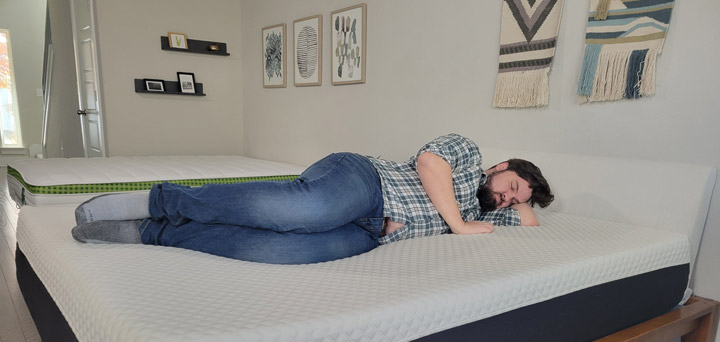
Unless you have to for other medical reasons, you should not sleep on your back if you have sleep apnea. This can exacerbate sleep apnea issues and cause your throat to collapse more while you sleep. If you must sleep on your back, keep your head elevated with a wedge pillow.
How To Get Better Rest With Sleep Apnea
To get better rest with sleep apnea, first off, seek treatment! Sleep apnea is not a condition you can handle on your own, and it should be taken seriously.
That being said, according to the Mayo Clinic, there are ways to make yourself more comfortable and ease sleep apnea symptoms. You can begin by making lifestyle changes. For instance, quitting smoking and cutting back on drinking close to bed can lessen apnea symptoms. Losing weight and exercising can also help.
Beyond that, make sure that you have a mattress and pillow that are fit for side sleeping. Your mattress should provide good pressure relief for your shoulders and hips, and your pillow should support your head.
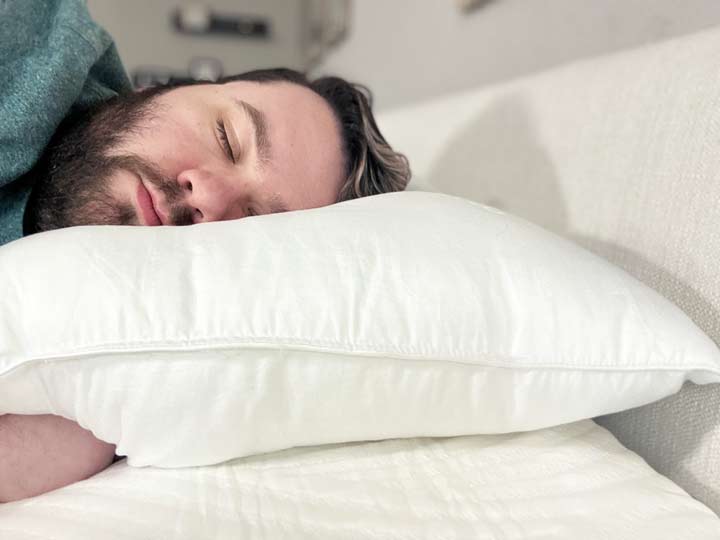
You shouldn’t sleep on your back unless you absolutely need to. If so, invest in a wedge pillow or adjustable base to keep your head elevated while you sleep. This can ease mild apnea.
Summary
Again, here are our top picks for the best pillows for sleep apneea.
| Pillow | Best For |
| Helix Wedge Pillow | Best Wedge Pillow for Sleep Apnea |
| Saatva Memory Foam Pillow | Best Pillow for Snoring |
| LUXOME LAYR | Best Adjustable Pillow for Sleep Apnea |
| Layla Kapok | Best Pillow for Side Sleepers |
| TEMPUR-Neck pillow | Best Pillow for Neck Pain |
| Lundberg CPAP Pillow | Best Pillow for Obstructive Sleep Apnea |
| Sutera | Best Cervical Pillow |
FAQs
How many pillows should I use for sleep apnea?
Side sleeping is best for sleep apnea, and you’ll only need one supportive pillow for this position. If you have to sleep on your back, you can use one wedge pillow or two pillows to elevate your head and keep your airway open.
How high should a wedge pillow be for sleep apnea?
Most experts recommend a wedge pillow should be between eight and 10 inches high for proper elevation.
Does sleeping upright help with sleep apnea?
Studies have shown that sleeping upright can reduce sleep apnea symptoms. It can also prevent your throat from collapsing so much during the night.
Does sleeping on your side help with sleep apnea?
Yes, side sleeping can help with sleep apnea. It can keep your airway open, preventing apnea incidents.
Can you have sleep apnea without snoring?
Even if you don’t snore, you may still have sleep apnea. You could still suffer from daytime symptoms such as fatigue and headaches.


